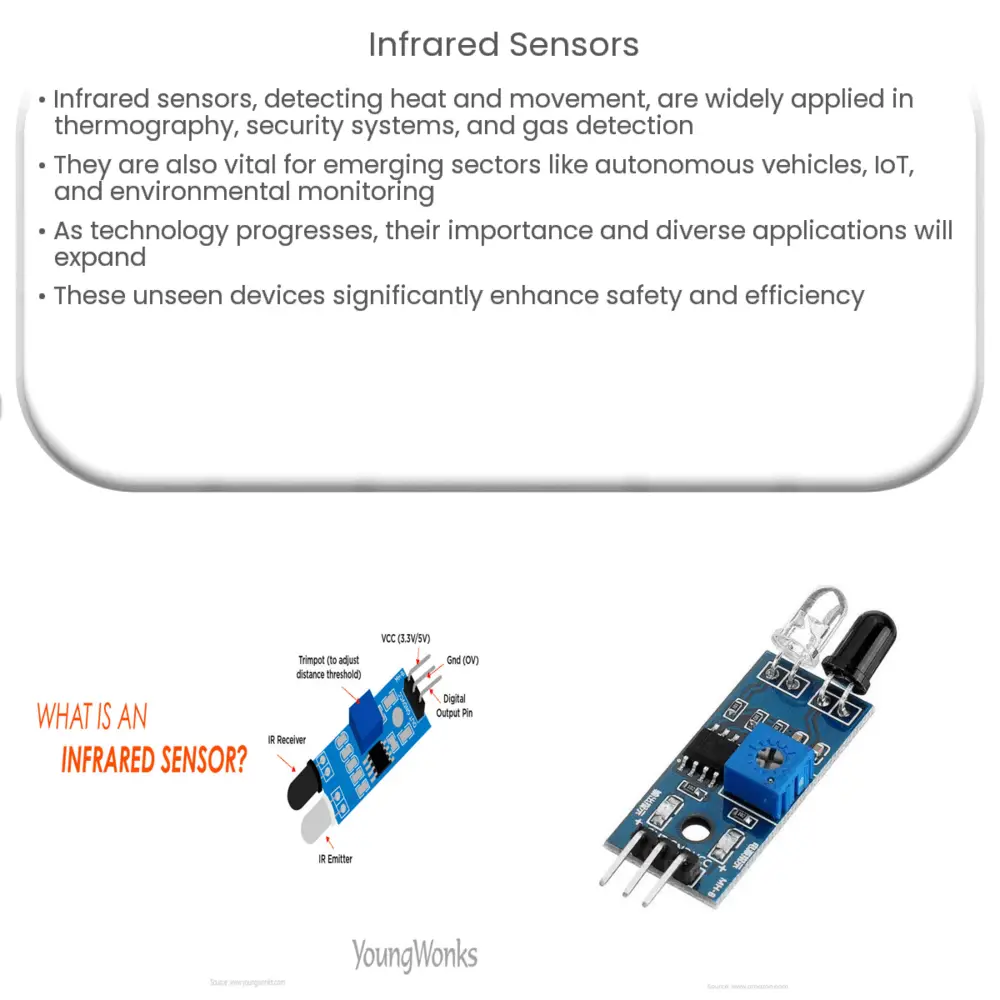Explore the unseen world of infrared sensors, their operation principles, diverse applications, and future developments in this comprehensive guide.

Infrared Sensors: Unseen Technology at Work
Infrared sensors are a type of electronic device that detect and measure infrared radiation—emitted by any object that has heat. Every object with a temperature above absolute zero (-273.15oC or 0 Kelvin) gives off this radiation, albeit not visible to the human eye.
How do Infrared Sensors Work?
Infrared sensors function based on the principle that infrared radiation is a component of the electromagnetic spectrum with a wavelength longer than visible light, which makes it undetectable to the human eye. However, these sensors, designed specifically to pick up on this radiation, can detect the change in radiation or heat and convert it into an electrical signal, which can then be interpreted or processed.
- Passive Infrared Sensors (PIR): These do not emit infrared signals but instead absorb the radiated heat of objects in their field of view. PIR sensors are mostly used in security systems and automated lighting systems.
- Active Infrared Sensors (AIR): Unlike PIR sensors, AIR sensors emit infrared signals. These sensors work on the principle of reflection, where the emitted radiation bounces off an object and returns to the sensor.
Applications of Infrared Sensors
Infrared sensors have a wide variety of applications, due to their ability to detect heat and movement. Here are a few prominent uses:
- Thermography: Infrared sensors play a critical role in thermography, where they detect heat loss in building enclosures, identify overheated components in machinery, and monitor temperature changes in medical diagnostics.
- Motion Detection: A common application is in security systems, where sensors detect changes in infrared radiation in their environment, indicating motion. This technology is also used in automatic doors and lights.
- Gas and Fire Detection: Infrared sensors are used in devices that detect specific gases and fires by identifying the unique infrared absorption patterns of different substances.
This represents just a small sampling of the applications of infrared sensors. These remarkable devices continue to find new uses, and ongoing advancements promise an even more diverse range of applications in the future.
Further Advancements and Developments
With advancements in technology and an increasing emphasis on automation and precision, the role of infrared sensors is set to expand significantly. We’re seeing a rise in their use in the fields of autonomous vehicles, IoT (Internet of Things), wearable technology, and environmental monitoring.
- Autonomous Vehicles: Infrared sensors are crucial in the development and operation of self-driving vehicles. They help these vehicles detect obstacles and other road users, even in low visibility conditions, ensuring a safer drive.
- IoT and Wearable Technology: As the IoT expands, infrared sensors are being integrated into various devices, from household appliances to wearable fitness trackers. In wearables, they’re used to monitor body temperature and heart rate, offering real-time health tracking.
- Environmental Monitoring: Infrared sensors play a pivotal role in environmental studies and weather forecasting. They assist in tracking vegetation growth, measuring soil moisture, and monitoring climate change by evaluating changes in earth’s surface temperature.
Further research and development in the field of infrared sensors are bound to provide even more precise and versatile applications. The potential for growth in this sector is immense, and it’s only a matter of time before we see more of these sensors in our daily lives.
Conclusion
In conclusion, infrared sensors are a fascinating blend of physics and technology, serving as a cornerstone in numerous sectors. While often invisible in their operations, their impacts are far-reaching, from enhancing security systems to fostering advancements in autonomous vehicles and environmental research. As technological advancements continue to evolve, the potential applications and importance of these sensors are only likely to grow. Despite their often unnoticed presence, infrared sensors truly represent an unseen technology at work, making our lives safer, easier, and more efficient.

